BBC News, Africa Correspondent
|
Sitting for a portrait is a curious exercise in intimacy and trust. You are exposing yourself to someone you hardly know, looking them in the face and inviting them to interpret you to the world, to capture you – in colour and shape and brushstroke – in a form that will probably outlive both of you. You are almost naked – sometimes literally so. You are surrendering control over the way you present yourself to the world, handing yourself to another, not only in the immediacy of the moment – here and now – but to posterity. It is not the momentary surrender of the holiday snap but something much more lasting, more probing. I like my face. It is not handsome or fine. It is not even symmetrical. But it is mine and when I look at it each morning in the mirror I catch glimpses of my father and mother. The man who looks back at me connects me every day – every moment – with those two loving, nurturing souls. And he has added to his physiognomy things of his own. His face is a map of his life. I know what he has seen through those eyes that meet mine, what he has know of this worked – the sorrows and joys he has chalked up thus far – and I know how this face reflects them and holds them in memory. I like his crooked unhandsome smile, for it is a reflection of the man I hold myself to be. |
 |
All this you surrender to a stranger when you sit for a portrait. I loved what I knew of the relative stranger who painted me. Like me, Fionna Carlisle had spent years in the Balkans. There was something very unScottish about the way her paintings used the Aegean colours of sunshine. I had seen here evocations of Greece the entire spectrum – from the pale white transparency of dawn to the burning crescendo of mid-day.
She could paint what I thought of as sun-scapes. She could make blue the colour of warmth. From time to time, during our sittings, she would answer the phone and conduct an animated conversation in Greek. She seemed not to know that she wasn’t using her native tongue. She seemed not to know that she was in her garret flat in the Grassmarket, with the grudging daylight of a Scottish winter spitting its pallid rays over the slate-grey of old Edinburgh.
So, I gave her this face of mine, surrendered all that I thought it stood for, for her to interpret.
Choosing how you will appear – what you will wear; whether you will sand or sit or lie prone; whether you will look the artist in the eye and with her all those who will see the portrait in the future, or whether you will gaze into the middle distance, or read a book – these choices that you make at the outset constitute the beginning of your engaging with the process of being portrayed. They are your consent, your complicity.
And – sheepishly at first, with much Scottish self-consciousness – I did begin to engage with the thing. I would sit for forty minutes, forty-five perhaps, at a stretch. Sometimes three or four stretches in a day, sometimes two or three times in the week. A ghostly shadow took shape on the white canvas. I saw myself, little by little, emerge from nothing, a single line here or there often radically changing the aspect or shape or mood of the image. It was not the man who looks back at me in the mirror, for your mirror face is never the face that others see.
In the year Scotland got its first parliament in three centuries I took this sense of myself and myself and put a kilt on it and I sat for Fionna in the oldest part of Scotland’s old-and-new capital. It seemed a fine and happy way to connect this face of mine to what was happening in the place that matters to me the most; a way for me to say that for all the years of wanderlust, for all the time spent in impossible places, at impossible distances, this country, at this time, is where I belong.
There were times when it would seem interminable, when a forty minute session would seem endless, Fionna would walk around the room, brush in hand, looking at me from this angle and that without the slightest indication that she was ready to make contact between brush and canvas and I would think ‘get on with it!’ as though paining a portrait the same thing as paining a door or ceiling.
At other times I would disappear for weeks on end, sit for a single session, preoccupied and agitated and then disappear again. Each time I came back and climbed the circular stone stair to her flat, the canvas was there. This weird unfinished representation of me – part manufactured, part quite startlingly organic – was waiting.
And in the end you engage with it fully. I began to think of the portrait not as Fionna’s work but as ‘ours’. One afternoon Fionna asked me whether I’d like to listen to the radio news to relieve the boredom of sitting, and she laughed out loud when I said no, that I thought this would spoil my concentration, interfere with my participation in this thing we were doing.
A photograph captures you as you are in an instant in time. Fionna Carlisle does not paint from photographs. She paints from life. And if you will surrender to her your face, your sense of who you are, she will capture you as she sees you, not at this moment in time, but at this point in your life, with all that you have seen and known and done, woven into the strokes of her brush.
Allan Little
Johannesburg, 2000
